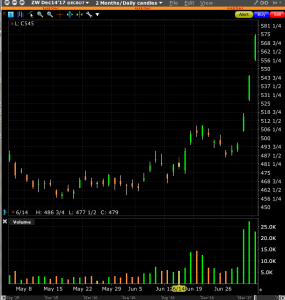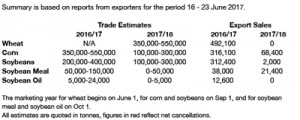- The new week starts with Chicago markets leaping higher with the row crops of corn and soybeans making new summer rally highs. Wheat futures have followed, as have London and Paris markets and traders are closely monitoring heat and dryness which may well be damaging crop potential in Canada as well as parts of Europe. The global supply of durum and high protein wheats can ill afford further losses at this time, unless of course we are to see higher prices beginning to ration demand. Wednesday’s NASS report is expected to sharply cut US spring and durum wheat yields in their first survey of the crop year. Traders in wheat will not want to be overly bearish in a market that could well see a 2017/18 crop decline of some 40 million mt. Tonight’s crop condition report is expected to show some decline.
- Private traders are further reducing their estimates of the 2017 Australian wheat harvest based on dryness and severe problems being reported with rodent infestations. Some analysts are now cutting their 2017 Aussie wheat crop estimate to 21-23.00 million mt, which is down substantially from last year’s 35 million mt harvest. Outside of Argentina, nearly every major world wheat producer will endure the harvest of a smaller wheat crop. It is not only soybeans, but canola (rapeseed) prices are soaring. Canola prices are at their highest levels since 2013 as the Canadian crop is being threatened by the hot and dry weather. There could be a real shortage of Canadian canola/canola oil in the next 12-13 months as supply shortages collide with strong demand, and improving import interest from China.
- The old trading saying goes: “The trend is your friend!” That trend applies not only in trading, but also weather. Historically, it is tough to find a year when Central US weather reverses during the middle of July. A close above $10.43 would likely set a target of at least $11.00 in Nov ‘17 soybeans while Dec corn has a target of $4.30-4.50. And amid the surging summer row crop prices, wheat futures are likely to retest their highs.


